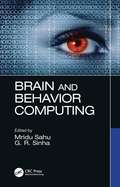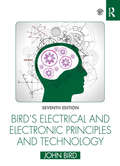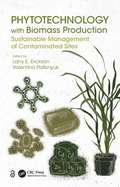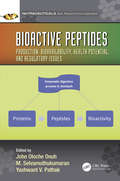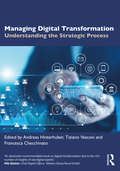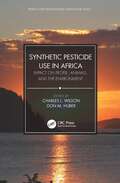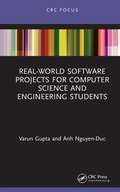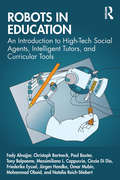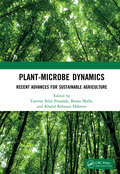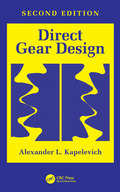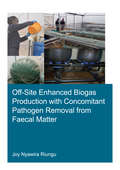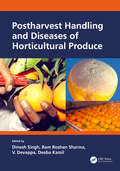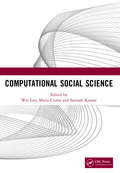- Table View
- List View
Brain and Behavior Computing
by Mridu Sahu G. R. SinhaBrain and Behavior Computing offers insights into the functions of the human brain. This book provides an emphasis on brain and behavior computing with different modalities available such as signal processing, image processing, data sciences, statistics further it includes fundamental, mathematical model, algorithms, case studies, and future research scopes. It further illustrates brain signal sources and how the brain signal can process, manipulate, and transform in different domains allowing researchers and professionals to extract information about the physiological condition of the brain. Emphasizes real challenges in brain signal processing for a variety of applications for analysis, classification, and clustering. Discusses data sciences and its applications in brain computing visualization. Covers all the most recent tools for analysing the brain and it’s working. Describes brain modeling and all possible machine learning methods and their uses. Augments the use of data mining and machine learning to brain computer interface (BCI) devices. Includes case studies and actual simulation examples. This book is aimed at researchers, professionals, and graduate students in image processing and computer vision, biomedical engineering, signal processing, and brain and behavior computing.
Bird's Electrical and Electronic Principles and Technology
by John BirdNow in its seventh edition, Bird’s Electrical and Electronic Principles and Technology introduces and covers theory through detailed examples and laboratory experiments, enabling students to gain knowledge required by technicians in fields such as engineering, electronics, and telecommunications. This edition includes several new sections, including glass batteries, climate change, the future of electricity production, and discussions concerning everyday aspects of electricity, such as watts and lumens, electrical safety, AC vs DC, and trending technologies. The extensive and thorough topic coverage makes this a great text for a range of level 2 and 3 engineering courses, which has helped thousands of students succeed in their exams. It is also suitable for BTEC First, National and Diploma syllabuses, City & Guilds Technician Certificate and Diploma syllabuses, and Foundation Degrees in engineering. Its companion website at www.routledge.com/cw/bird provides resources for both students and lecturers, including full solutions for all 900 further questions, lists of essential formulae, multiple-choice tests and illustrations, as well as full solutions to revision tests and lab experiments for course instructors.
Brain and Behavior Computing
by Mridu SahuBrain and Behavior Computing offers insights into the functions of the human brain. This book provides an emphasis on brain and behavior computing with different modalities available such as signal processing, image processing, data sciences, statistics further it includes fundamental, mathematical model, algorithms, case studies, and future research scopes. It further illustrates brain signal sources and how the brain signal can process, manipulate, and transform in different domains allowing researchers and professionals to extract information about the physiological condition of the brain. Emphasizes real challenges in brain signal processing for a variety of applications for analysis, classification, and clustering. Discusses data sciences and its applications in brain computing visualization. Covers all the most recent tools for analysing the brain and it’s working. Describes brain modeling and all possible machine learning methods and their uses. Augments the use of data mining and machine learning to brain computer interface (BCI) devices. Includes case studies and actual simulation examples. This book is aimed at researchers, professionals, and graduate students in image processing and computer vision, biomedical engineering, signal processing, and brain and behavior computing.
Bird's Electrical and Electronic Principles and Technology
by John BirdNow in its seventh edition, Bird’s Electrical and Electronic Principles and Technology introduces and covers theory through detailed examples and laboratory experiments, enabling students to gain knowledge required by technicians in fields such as engineering, electronics, and telecommunications. This edition includes several new sections, including glass batteries, climate change, the future of electricity production, and discussions concerning everyday aspects of electricity, such as watts and lumens, electrical safety, AC vs DC, and trending technologies. The extensive and thorough topic coverage makes this a great text for a range of level 2 and 3 engineering courses, which has helped thousands of students succeed in their exams. It is also suitable for BTEC First, National and Diploma syllabuses, City & Guilds Technician Certificate and Diploma syllabuses, and Foundation Degrees in engineering. Its companion website at www.routledge.com/cw/bird provides resources for both students and lecturers, including full solutions for all 900 further questions, lists of essential formulae, multiple-choice tests and illustrations, as well as full solutions to revision tests and lab experiments for course instructors.
Phytotechnology with Biomass Production: Sustainable Management of Contaminated Sites
by Larry E. Erickson Valentina PidlisnyukThis book explains the concept of using phytotechnology with biomass production to improve soil quality and restore contaminated sites to a useful state that has economic and social value. Phytotechnology with Biomass Production: Sustainable Management of Contaminated Sites focuses on the application of second-generation biofuel crops, primarily Miscanthus, to slightly contaminated or marginal postmilitary and postmining soils. Based on recent and ongoing research from the United States, Ukraine, the Czech Republic, and Germany, along with case studies from other countries, this is the first comprehensive book on using phytotechnology with biomass production at contaminated sites at a global level. FEATURES Focuses on an important topic of a growing global activity: soil improvement through biomass production Includes case studies and success stories from different countries on application of Miscanthus phytotechnology to sites differently contaminated by trace elements, pesticides, and petroleum products Discusses the peculiarities of Miscanthus production on postmilitary and postmining contaminated lands and the impact of plant growth regulators, soil amendments, fertilizers, and biochar to the process Introduces soil fauna as indicators of soil health during Miscanthus phytotechnology application Presents Miscanthus value chain associated with the processing of Miscanthus biomass to different bioproducts While written primarily for faculty, students, research scientists, environmental and agricultural professionals, gardeners, farmers, landowners, and government officials, this book has value for all who are working on phytotechnology projects and phytomining to reduce risk and/or improve soil quality at contaminated sites. Phytotechnology with Biomass Production: Sustainable Management of Contaminated Sites is also a great new resource for those who are new to the topic and want to learn to apply phytotechnologies and biomass production with further conversion into energy and bioproducts.
Phytotechnology with Biomass Production: Sustainable Management of Contaminated Sites
by Larry E. Erickson Valentina PidlisnyukThis book explains the concept of using phytotechnology with biomass production to improve soil quality and restore contaminated sites to a useful state that has economic and social value. Phytotechnology with Biomass Production: Sustainable Management of Contaminated Sites focuses on the application of second-generation biofuel crops, primarily Miscanthus, to slightly contaminated or marginal postmilitary and postmining soils. Based on recent and ongoing research from the United States, Ukraine, the Czech Republic, and Germany, along with case studies from other countries, this is the first comprehensive book on using phytotechnology with biomass production at contaminated sites at a global level. FEATURES Focuses on an important topic of a growing global activity: soil improvement through biomass production Includes case studies and success stories from different countries on application of Miscanthus phytotechnology to sites differently contaminated by trace elements, pesticides, and petroleum products Discusses the peculiarities of Miscanthus production on postmilitary and postmining contaminated lands and the impact of plant growth regulators, soil amendments, fertilizers, and biochar to the process Introduces soil fauna as indicators of soil health during Miscanthus phytotechnology application Presents Miscanthus value chain associated with the processing of Miscanthus biomass to different bioproducts While written primarily for faculty, students, research scientists, environmental and agricultural professionals, gardeners, farmers, landowners, and government officials, this book has value for all who are working on phytotechnology projects and phytomining to reduce risk and/or improve soil quality at contaminated sites. Phytotechnology with Biomass Production: Sustainable Management of Contaminated Sites is also a great new resource for those who are new to the topic and want to learn to apply phytotechnologies and biomass production with further conversion into energy and bioproducts.
Bioactive Peptides: Production, Bioavailability, Health Potential, and Regulatory Issues (Nutraceuticals)
by John Oloche Onuh M. Selvamuthukumaran Yashwant V. PathakBioactive peptides have been receiving attention recently due to their applications as health-promoting agents. Derived from food proteins and other natural sources, they exhibit various beneficial effects such as preventing diseases or modulating physiological systems once absorbed. As the market for nutraceuticals and functional foods continues to expand, consumer interest has also grown and there are many common foods that have shown an abundance of bioactive peptides, including dairy products, cereal, legumes, meat, and numerous other sources. In this newest addition to the series Nutraceuticals: Basic Research and Clinical Applications, Bioactive Peptides: Production, Bioavailability, Health Potential, and Regulatory Issues provides a comprehensive review of the current state of knowledge in the field of food protein hydrolysates and bioactive peptides, their food sources, bioavailability, production, applications, functionalities, health potentials, and regulatory issues governing their use. Features Discusses different methodologies employed for scaling up bioactive peptides commercially Provides information on optimizing the production process Explains various bioactive properties exerted by different types of bioactive peptides Explores the application of metabolomics to the study of bioactive peptides With over 20 chapters written by established subject matter experts in their field, this book provides timely information and discusses the latest developments of bioactive peptides. It will be useful for researchers, academics, and industry experts, and can serve as an excellent resource for anyone interested in enhancing their knowledge in the field of bioactive peptides.
Bioactive Peptides: Production, Bioavailability, Health Potential, and Regulatory Issues (Nutraceuticals)
by John Oloche Onuh M. Selvamuthukumaran Yashwant V. PathakBioactive peptides have been receiving attention recently due to their applications as health-promoting agents. Derived from food proteins and other natural sources, they exhibit various beneficial effects such as preventing diseases or modulating physiological systems once absorbed. As the market for nutraceuticals and functional foods continues to expand, consumer interest has also grown and there are many common foods that have shown an abundance of bioactive peptides, including dairy products, cereal, legumes, meat, and numerous other sources. In this newest addition to the series Nutraceuticals: Basic Research and Clinical Applications, Bioactive Peptides: Production, Bioavailability, Health Potential, and Regulatory Issues provides a comprehensive review of the current state of knowledge in the field of food protein hydrolysates and bioactive peptides, their food sources, bioavailability, production, applications, functionalities, health potentials, and regulatory issues governing their use. Features Discusses different methodologies employed for scaling up bioactive peptides commercially Provides information on optimizing the production process Explains various bioactive properties exerted by different types of bioactive peptides Explores the application of metabolomics to the study of bioactive peptides With over 20 chapters written by established subject matter experts in their field, this book provides timely information and discusses the latest developments of bioactive peptides. It will be useful for researchers, academics, and industry experts, and can serve as an excellent resource for anyone interested in enhancing their knowledge in the field of bioactive peptides.
Managing Digital Transformation: Understanding the Strategic Process
by Andreas Hinterhuber Tiziano Vescovi Francesca ChecchinatoThis book provides practising executives and academics with the theories and best practices to plan and implement the digital transformation successfully. Key benefits: an overview on how leading companies plan and implement digital transformation interviews with chief executive officers and chief digital officers of leading companies – Bulgari, Deutsche Bahn, Henkel, Lanxess, L’Oréal, Unilever, Thales and others – explore lessons learnt and roadmaps to successful implementation research and case studies on the digitalization of small and medium-sized companies cutting-edge academic research on business models, organizational capabilities and performance implications of the digital transformation tools and insights into how to overcome internal resistance, build digital capabilities, align the organization, develop the ecosystem and create customer value to implement digital strategies that increase profits Managing Digital Transformation is unique in its approach, combining rigorous academic theory with practical insights and contributions from companies that are, according to leading academic thinkers, at the forefront of global best practice in the digital transformation. It is a recommended reading both for practitioners looking to implement digital strategies within their own organisations, as well as for academics and postgraduate students studying digital transformation, strategy and marketing.
Managing Digital Transformation: Understanding the Strategic Process
by Andreas HinterhuberThis book provides practising executives and academics with the theories and best practices to plan and implement the digital transformation successfully. Key benefits: an overview on how leading companies plan and implement digital transformation interviews with chief executive officers and chief digital officers of leading companies – Bulgari, Deutsche Bahn, Henkel, Lanxess, L’Oréal, Unilever, Thales and others – explore lessons learnt and roadmaps to successful implementation research and case studies on the digitalization of small and medium-sized companies cutting-edge academic research on business models, organizational capabilities and performance implications of the digital transformation tools and insights into how to overcome internal resistance, build digital capabilities, align the organization, develop the ecosystem and create customer value to implement digital strategies that increase profits Managing Digital Transformation is unique in its approach, combining rigorous academic theory with practical insights and contributions from companies that are, according to leading academic thinkers, at the forefront of global best practice in the digital transformation. It is a recommended reading both for practitioners looking to implement digital strategies within their own organisations, as well as for academics and postgraduate students studying digital transformation, strategy and marketing.
Synthetic Pesticide Use in Africa: Impact on People, Animals, and the Environment (World Food Preservation Center Book Series)
by Charles L. Wilson Don M. HuberA UN report presented to the UN Human Rights Council in 2017 recognized that, “although pesticide use has been correlated with a rise in food production, it has had catastrophic impacts" on human health and the environment. The report acknowledged that “increased food production has not succeeded in eliminating hunger worldwide because of the many interacting factors involved. Reliance on hazardous pesticides is a short-term solution that undermines the rights to adequate food and health for present and future generations."It is hoped that the knowledge available in Synthetic Pesticide Use in Africa: Impact on People, Animals, and the Environment will both enlighten the reader to present serious concerns on the use of synthetic pesticides, and motivate society to make the changes necessary for the sustainable production of safe, nutritious, and affordable food for the anticipated 9.6 billion inhabitants of this Earth in 2050. Key Features:• Explains the relationship of synthetic pesticides to escalating noncommunicable human and animal diseases in Africa and developing countries.• Discusses the impact of the herbicide glyphosate on the health of humans, animals, and the environment.• Reviews the disease causing mode of action of glyphosate and other synthetic pesticides on nutrient density and human and animal bodies.• Warns of the special vulnerability of children to synthetic pesticide toxicity.• Recommends needed legal initiatives to use synthetic pesticides more judiciously.The book is divided into seven (7) sections: I. General Impact, explains the general impact of synthetic pesticides on the African people, their animals, and environment. II. Human Health, covers the impact of synthetic pesticides on the human body, while III, Children’s Health, focuses on the special vulnerability of children to synthetic pesticides. IV. Animal Health describes the synthetic pesticide threats to animal production and sustainability. V. Environmental Health presents the threat of synthetic pesticides to soil microbiota and sustainable remediations. VI. Control Strategies discusses biologically-based alternatives to synthetic pesticides. Finally, VII. Reglatory Control presents some legal initiatives to combat the misuse of synthetic pesticides.
Synthetic Pesticide Use in Africa: Impact on People, Animals, and the Environment (World Food Preservation Center Book Series)
by Charles L. Wilson Don M. HuberA UN report presented to the UN Human Rights Council in 2017 recognized that, “although pesticide use has been correlated with a rise in food production, it has had catastrophic impacts" on human health and the environment. The report acknowledged that “increased food production has not succeeded in eliminating hunger worldwide because of the many interacting factors involved. Reliance on hazardous pesticides is a short-term solution that undermines the rights to adequate food and health for present and future generations."It is hoped that the knowledge available in Synthetic Pesticide Use in Africa: Impact on People, Animals, and the Environment will both enlighten the reader to present serious concerns on the use of synthetic pesticides, and motivate society to make the changes necessary for the sustainable production of safe, nutritious, and affordable food for the anticipated 9.6 billion inhabitants of this Earth in 2050. Key Features:• Explains the relationship of synthetic pesticides to escalating noncommunicable human and animal diseases in Africa and developing countries.• Discusses the impact of the herbicide glyphosate on the health of humans, animals, and the environment.• Reviews the disease causing mode of action of glyphosate and other synthetic pesticides on nutrient density and human and animal bodies.• Warns of the special vulnerability of children to synthetic pesticide toxicity.• Recommends needed legal initiatives to use synthetic pesticides more judiciously.The book is divided into seven (7) sections: I. General Impact, explains the general impact of synthetic pesticides on the African people, their animals, and environment. II. Human Health, covers the impact of synthetic pesticides on the human body, while III, Children’s Health, focuses on the special vulnerability of children to synthetic pesticides. IV. Animal Health describes the synthetic pesticide threats to animal production and sustainability. V. Environmental Health presents the threat of synthetic pesticides to soil microbiota and sustainable remediations. VI. Control Strategies discusses biologically-based alternatives to synthetic pesticides. Finally, VII. Reglatory Control presents some legal initiatives to combat the misuse of synthetic pesticides.
Real-World Software Projects for Computer Science and Engineering Students
by Varun Gupta Anh Nguyen-DucDeveloping projects outside of a classroom setting can be intimidating for students and is not always a seamless process. Real-World Software Projects for Computer Science and Engineering Students is a quick, easy source for tackling such issues. Filling a critical gap in the research literature, the book: Is ideal for academic project supervisors. Helps researchers conduct interdisciplinary research. Guides computer science students on undertaking and implementing research-based projects This book explains how to develop highly complex, industry-specific projects touching on real-world complexities of software developments. It shows how to develop projects for students who have not yet had the chance to gain real-world experience, providing opportunity to become familiar with the skills needed to implement projects using standard development methodologies. The book is also a great source for teachers of undergraduate students in software engineering and computer science as it can help students prepare for the risk and uncertainty that is typical of software development in industrial settings.
Real-World Software Projects for Computer Science and Engineering Students
by Varun Gupta Anh Nguyen-DucDeveloping projects outside of a classroom setting can be intimidating for students and is not always a seamless process. Real-World Software Projects for Computer Science and Engineering Students is a quick, easy source for tackling such issues. Filling a critical gap in the research literature, the book: Is ideal for academic project supervisors. Helps researchers conduct interdisciplinary research. Guides computer science students on undertaking and implementing research-based projects This book explains how to develop highly complex, industry-specific projects touching on real-world complexities of software developments. It shows how to develop projects for students who have not yet had the chance to gain real-world experience, providing opportunity to become familiar with the skills needed to implement projects using standard development methodologies. The book is also a great source for teachers of undergraduate students in software engineering and computer science as it can help students prepare for the risk and uncertainty that is typical of software development in industrial settings.
Robots in Education: An Introduction to High-Tech Social Agents, Intelligent Tutors, and Curricular Tools
by Fady Alnajjar Christoph Bartneck Paul Baxter Tony Belpaeme Massimiliano Cappuccio Cinzia Di Dio Friederike Eyssel Jürgen Handke Omar Mubin Mohammad Obaid Natalia Reich-StiebertRobots in Education is an accessible introduction to the use of robotics in formal learning, encompassing pedagogical and psychological theories as well as implementation in curricula. Today, a variety of communities across education are increasingly using robots as general classroom tutors, tools in STEM projects, and subjects of study. This volume explores how the unique physical and social-interactive capabilities of educational robots can generate bonds with students while freeing instructors to focus on their individualized approaches to teaching and learning. Authored by a uniquely interdisciplinary team of scholars, the book covers the basics of robotics and their supporting technologies; attitudes toward and ethical implications of robots in learning; research methods relevant to extending our knowledge of the field; and more.
Robots in Education: An Introduction to High-Tech Social Agents, Intelligent Tutors, and Curricular Tools
by Fady Alnajjar Christoph Bartneck Paul Baxter Tony Belpaeme Massimiliano Cappuccio Cinzia Di Dio Friederike Eyssel Jürgen Handke Omar Mubin Mohammad Obaid Natalia Reich-StiebertRobots in Education is an accessible introduction to the use of robotics in formal learning, encompassing pedagogical and psychological theories as well as implementation in curricula. Today, a variety of communities across education are increasingly using robots as general classroom tutors, tools in STEM projects, and subjects of study. This volume explores how the unique physical and social-interactive capabilities of educational robots can generate bonds with students while freeing instructors to focus on their individualized approaches to teaching and learning. Authored by a uniquely interdisciplinary team of scholars, the book covers the basics of robotics and their supporting technologies; attitudes toward and ethical implications of robots in learning; research methods relevant to extending our knowledge of the field; and more.
Plant-Microbe Dynamics: Recent Advances for Sustainable Agriculture
by Tanveer Bilal Pirzadah Bisma Malik Khalid Rehman HakeemPlants and microbes have co-evolved and interacted with each other in nature. Understanding the complex nature of the plant-microbe interface can pave the way for novel strategies to improve plant productivity in an eco-friendly manner. The microbes associated with plants, often called plant microbiota, are an integral part of plant life. The significance of the plant microbiome is a reliable approach toward sustainability to meet future food crises and rejuvenate soil health. Profiling plant-associate microbiomes (genome assemblies of all microbes) is an emerging concept in understanding plant-microbe interactions. Microbiota extends the plant capacity to acclimatize fluctuating environmental conditions through several mechanisms. Thus, unraveling the mystery of plant-microbe dynamics through latest technologies to better understand the role of metabolites and signal pathway mechanisms is very important. This book shares the latest insight on omics technologies to unravel plant-microbe dynamic interactions and other novel phytotechnologies for cleaning contaminated soils. Besides, it also provides brief insight on the recently discovered clustered regularly interspaced short palindromic repeats CRISPR-Cas9, which is a genome editing tool to explore plant-microbe interactions and how this genome editing tool helps to improve the ability of microbes/plants to combat abiotic/biotic stresses.
Direct Gear Design
by Alexander L. KapelevichThe updated and improved second edition of Direct Gear Design details a nonstandard gear design approach that makes it possible to significantly improve gear drive performance. Providing engineers with gear design solutions beyond standard limits, this book delivers engineers with practical and innovative solutions to optimize gearing technologies.The majority of modern gears are over-standardized, not allowing gear design engineers to see possible gear design solutions outside of standard limits. The book explores opportunities to improve and optimize gears beyond these limitations. The method of Direct Gear Design has been proven to maximise gear drive performance, increase transmission load capacity and efficiency, and reduce size and weight. Discussing the use of gears made from powder metal and plastic, the book surveys gear manufacture and makes use of extensive references to encourage further exploration of gear design innovation. Additionally, the book provides an overview of manufacturing technologies and traditional gear design, as well as covering topics such as asymmetric gears, tolerance selection and measurement methods of custom gears.Written accessibly, with a focus on practical examples, this fully updated edition will serve as a guidebook for all professionals exploring high-performance gearing system technologies.
Plant-Microbe Dynamics: Recent Advances for Sustainable Agriculture
by Tanveer Bilal PirzadahPlants and microbes have co-evolved and interacted with each other in nature. Understanding the complex nature of the plant-microbe interface can pave the way for novel strategies to improve plant productivity in an eco-friendly manner. The microbes associated with plants, often called plant microbiota, are an integral part of plant life. The significance of the plant microbiome is a reliable approach toward sustainability to meet future food crises and rejuvenate soil health. Profiling plant-associate microbiomes (genome assemblies of all microbes) is an emerging concept in understanding plant-microbe interactions. Microbiota extends the plant capacity to acclimatize fluctuating environmental conditions through several mechanisms. Thus, unraveling the mystery of plant-microbe dynamics through latest technologies to better understand the role of metabolites and signal pathway mechanisms is very important. This book shares the latest insight on omics technologies to unravel plant-microbe dynamic interactions and other novel phytotechnologies for cleaning contaminated soils. Besides, it also provides brief insight on the recently discovered clustered regularly interspaced short palindromic repeats CRISPR-Cas9, which is a genome editing tool to explore plant-microbe interactions and how this genome editing tool helps to improve the ability of microbes/plants to combat abiotic/biotic stresses.
Direct Gear Design
by Alexander L. KapelevichThe updated and improved second edition of Direct Gear Design details a nonstandard gear design approach that makes it possible to significantly improve gear drive performance. Providing engineers with gear design solutions beyond standard limits, this book delivers engineers with practical and innovative solutions to optimize gearing technologies.The majority of modern gears are over-standardized, not allowing gear design engineers to see possible gear design solutions outside of standard limits. The book explores opportunities to improve and optimize gears beyond these limitations. The method of Direct Gear Design has been proven to maximise gear drive performance, increase transmission load capacity and efficiency, and reduce size and weight. Discussing the use of gears made from powder metal and plastic, the book surveys gear manufacture and makes use of extensive references to encourage further exploration of gear design innovation. Additionally, the book provides an overview of manufacturing technologies and traditional gear design, as well as covering topics such as asymmetric gears, tolerance selection and measurement methods of custom gears.Written accessibly, with a focus on practical examples, this fully updated edition will serve as a guidebook for all professionals exploring high-performance gearing system technologies.
Off-Site Enhanced Biogas Production with Concomitant Pathogen Removal from Faecal Matter (IHE Delft PhD Thesis Series)
by Joy Nyawira RiunguGlobally, 2.7 billion people are using onsite sanitation systems, particularly in low income, high density settlements (LIHDS) in urban areas of developing countries. However, treatment technologies to manage the faecal sludge (FS) generated from these systems are often not in place, leading to high risks for environmental and public health. The development of replicable and effective technologies for FS treatment is key in addressing this challenge. This research focused on development of an innovative FS stabilisation technology and addressed key constraints in anaerobic FS treatment: inadequate pathogen inactivation and limitations in biochemical energy recovery. The developed two-stage reactor system consists of an acidogenic reactor fed with mixtures of FS and market waste to facilitate pathogen inactivation, and a subsequent methanogenic plug-flow reactor for enhanced methane production. Due to its potential for application as an off-site FS treatment technology at any scale, receiving any type of faecal matter, collected from different types of sanitary systems, the system provides an option for FS stabilisation for LIHDS. Additionally, the research evaluated the limitations of sanitation provision in LIHDS, and proposes methods for creating an enabling environment for full-scale implementation of onsite systems. The presented results contribute to designing appropriate sanitation interventions in LIHDS.
Off-Site Enhanced Biogas Production with Concomitant Pathogen Removal from Faecal Matter (IHE Delft PhD Thesis Series)
by Joy Nyawira RiunguGlobally, 2.7 billion people are using onsite sanitation systems, particularly in low income, high density settlements (LIHDS) in urban areas of developing countries. However, treatment technologies to manage the faecal sludge (FS) generated from these systems are often not in place, leading to high risks for environmental and public health. The development of replicable and effective technologies for FS treatment is key in addressing this challenge. This research focused on development of an innovative FS stabilisation technology and addressed key constraints in anaerobic FS treatment: inadequate pathogen inactivation and limitations in biochemical energy recovery. The developed two-stage reactor system consists of an acidogenic reactor fed with mixtures of FS and market waste to facilitate pathogen inactivation, and a subsequent methanogenic plug-flow reactor for enhanced methane production. Due to its potential for application as an off-site FS treatment technology at any scale, receiving any type of faecal matter, collected from different types of sanitary systems, the system provides an option for FS stabilisation for LIHDS. Additionally, the research evaluated the limitations of sanitation provision in LIHDS, and proposes methods for creating an enabling environment for full-scale implementation of onsite systems. The presented results contribute to designing appropriate sanitation interventions in LIHDS.
Postharvest Handling and Diseases of Horticultural Produce
by Dinesh Singh Ram Roshan Sharma V. Devappa Deeba KamilPostharvest Handling and Diseases of Horticultural Produce describes all the postharvest techniques, handling, pre-cooling, postharvest treatment, edible coating and storage of the horticultural produce available to handle perishable horticultural food commodities, covering the areas of horticulture, agricultural process engineering, postharvest technology, plant pathology and microbiology. Postharvest diseases of major fruits and vegetables, with their causal agents, are described. The integrative strategies for management of postharvest diseases include effectively inhibiting the growth of pathogens, enhancing the resistance of hosts and improving environmental conditions, with results that are favourable to the host and unfavourable to the pathogen growth including biotechnological approaches. Adopting a thematic style, chapters are organized by type of treatment, with sections devoted to postharvest risk factors and their amelioration. The chapters are written by experts in the fields of plant pathology, horticulture, food science etc., and core insights into identifying and utilizing appropriate postharvest options for minimizing postharvest losses and enhancing benefits to end-users are provided. Features Presents the most recent developments in the field of postharvest handling technologies and diseases in a single volume Includes postharvest diseases of cut flowers, fruits, vegetables and tuber crops. Appropriate for students, researchers and professionals Written by experts and can be used as a reference resource
Postharvest Handling and Diseases of Horticultural Produce
by Dinesh SinghPostharvest Handling and Diseases of Horticultural Produce describes all the postharvest techniques, handling, pre-cooling, postharvest treatment, edible coating and storage of the horticultural produce available to handle perishable horticultural food commodities, covering the areas of horticulture, agricultural process engineering, postharvest technology, plant pathology and microbiology. Postharvest diseases of major fruits and vegetables, with their causal agents, are described. The integrative strategies for management of postharvest diseases include effectively inhibiting the growth of pathogens, enhancing the resistance of hosts and improving environmental conditions, with results that are favourable to the host and unfavourable to the pathogen growth including biotechnological approaches. Adopting a thematic style, chapters are organized by type of treatment, with sections devoted to postharvest risk factors and their amelioration. The chapters are written by experts in the fields of plant pathology, horticulture, food science etc., and core insights into identifying and utilizing appropriate postharvest options for minimizing postharvest losses and enhancing benefits to end-users are provided. Features Presents the most recent developments in the field of postharvest handling technologies and diseases in a single volume Includes postharvest diseases of cut flowers, fruits, vegetables and tuber crops. Appropriate for students, researchers and professionals Written by experts and can be used as a reference resource
Computational Social Science: Proceedings of the 1st International Conference on New Computational Social Science (ICNCSS 2020), September 25-27, 2020, Guangzhou, China
by Wei Luo Maria Ciurea Santosh KumarSelected papers from the International Conference on New Computational Social Science, focusing on the following five aspects: Big data acquisition and analysis, Integration of qualitative research and quantitative research, Sociological Internet experiment research, Application of ABM simulation method in Sociology Research, Research and development of new social computing tools. With the rapid development of information technology, especially sweeping progress in the Internet of things, cloud computing, social networks, social media and big data, social computing, as a data-intensive science, is an emerging field that leverages the capacity to collect and analyze data with an unprecedented breadth, depth and scale. It represents a new computing paradigm and an interdisciplinary field of research and application. A broad comprehension of major topics involved in social computing is important for both scholars and practitioners. This proceedings presents and discusses key concepts and analyzes the state-of-the-art of the field. The conference not only gave insights on social computing, but also affords conduit for future research in the field. Social computing has two distinct trends: One is on the social science issues, such as computational social science, computational sociology, social network analysis, etc; The other is on the use of computational techniques. Finally some new challenges ahead are summarized, including interdisciplinary cooperation and training, big data sharing for scientific data mashups, and privacy protect.
